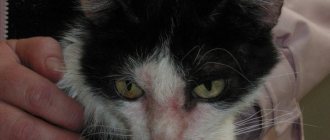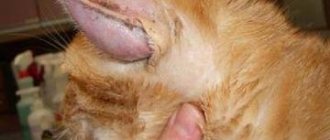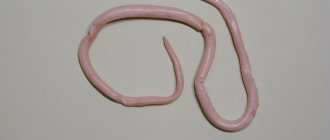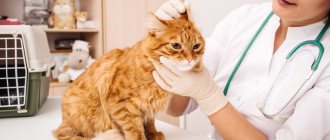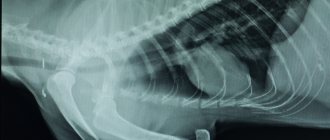6252Pavel
The appearance of a hernia in a cat is always an unpleasant surprise for its owners. It entails not only financial and time costs for the treatment of this disease, but also may well cause serious complications in the animal, and in some cases, the death of the cat. A hernia in a cat’s abdomen is especially dangerous, as it has the most negative effect on the animal’s body compared to other types of hernias.
In this article we will tell you about the symptoms, treatment methods and possible consequences of this unpleasant and dangerous disease. These recommendations will help you take appropriate measures to save your pet, as well as avoid a possible relapse of the disease.
© shutterstock
Types of hernias
Based on the nature of its occurrence, it is divided into congenital and acquired.
Based on their location on the animal’s body, the following types are distinguished:
- Diaphragmatic - organs from the abdominal cavity are displaced into the thoracic cavity. Most often, such a hernia is traumatic in nature. They are characterized by the development of shortness of breath, lethargy, and apathy in the cat. There is a risk of pulmonary edema.
- Intervertebral - displacement and pinching of the intervertebral disc. Characteristic of older individuals. Most often localized in the lumbosacral region. The cat's coordination of movements is impaired; he cannot climb the stairs. This hernia can lead to muscle atrophy and partial or complete paralysis.
- Perineal is the most dangerous, but rare type. When organs prolapse into the chest area, compression of the heart and lungs occurs, which impedes their normal functioning. Without surgical intervention, it quickly leads to the death of the pet.
- Umbilical - formed when abdominal organs prolapse through the fibrous ring. Most often it is congenital. Visually and upon palpation, it is perceived as a soft ball on the pet’s abdomen. In the early stages, if the formation is small, it can be easily reduced. But in complex cases it can lead to significant prolapse of internal organs and tissue necrosis.
- Inguinal - pinching of the spermatic cord when it prolapses in males (congenital or after castration), prolapse of the uterus or fallopian tubes - in females. In the latter, it is provoked by childbirth, sterilization, and flatulence. Usually the pet’s appearance and behavior does not cause alarm, but it can lead to serious consequences, including infertility and death of the animal.
- Perineal - more common in females - prolapse of the bladder between the uterus and rectum, in cats - parts of the peritoneum between the bladder and rectum. Usually it is post-operative in nature, not painful and can be easily eliminated non-surgically.
Why is an umbilical hernia dangerous for kittens?
Hernias on a kitten's stomach often do not cause the animal much discomfort. However, as your pet grows, its internal organs will begin to enlarge. As a result of this, the umbilical ring, which does not change its previous size, begins to put pressure on the prolapsed part of the organ. This leads to painful sensations in the abdominal cavity. The cat begins to behave restlessly, her temperature increases, and her appetite disappears. Sometimes the animal vomits.
Vomiting in a kitten: why and what to do about nausea
In addition to the pet’s poor health, the danger of a hernia lies in the disruption of blood circulation in the compressed part of the intestine. This leads to irreversible changes in intestinal tissue. Without proper treatment, your pet begins to experience tissue necrosis.
Reference! Necrosis progresses rapidly, leading to intoxication of the entire body. The result is shock and sepsis.
The described dangers lead to the death of the pet.
Mr. Cat explains: umbilical hernia in a kitten
The kitten in the womb is connected to her by the umbilical canaliculus. During childbirth, the cat gnaws the umbilical cord, the appendage remaining on the kitten’s abdomen is most often not bandaged; on the third or fourth day it dries out and falls off on its own, and the wound heals. If the muscles of the abdominal cavity are insufficiently developed, a lumen remains in the newborn and part of the internal organs, usually the small intestine, falls into this hole. This type of developmental disorder is predominantly hereditary. With growing up, the defect can be eliminated; the muscles often grow together on their own.
What is a hernia
As in the case of humans, a hernia in a cat is a formation in the abdominal area, which can be of different sizes. That is why it would be a good idea for you to study photos of hernias in cats so that if such a problem is discovered, you will roughly understand the complexity of the whole situation.
If you notice a small formation on the abdomen, which does not cause any discomfort to your pet, then you should not start to panic and get nervous.
As long as the animal does not show obvious signs of restless behavior, nothing terrible is happening, but you still need to contact a veterinarian.
Most likely, your attempts at self-medication will only make things worse and harm the animal even more.
Another common feature of this disease in humans and cats is that the hernia can be acquired or congenital.
Most often, for a long time you do not know what a hernia looks like in cats, because its most common variant is the acquired version.
This usually happens as a result of physical injuries that were associated with a fall from a great height or simply a strong blow - another reason why you don’t need to test your strength and physical superiority on a cat.
Treatment of hernia in cats
The appearance of hernia symptoms should not be ignored. Especially when it comes to a newborn kitten. Only a veterinarian can decide whether the size of the fibrous ring is dangerous for the subsequent development of the baby, and whether it is possible to cope without surgical intervention. If the size of the hole is large, prolapse of the mesentery or intestinal ring becomes dangerous, and some of the internal organs die.
If conservative treatment is possible, the kitten will need to wear a special blanket for about a month. The veterinarian puts the prolapsed organ back in place with his fingers, and then puts it on the kitten.
Surgical intervention is used more often in modern veterinary medicine, since this method is more effective. An umbilical hernia in a kitten is operated on after it reaches six months. After surgery to remove a hernia, the cat wears a blanket for about two weeks.
It is strictly forbidden to self-medicate by applying heating pads, herbs to the belly of a kitten or cat, doing massages, or applying compression bandages. With these methods it is very easy to harm your pet and lose it.
An inguinal hernia can only be eliminated by suturing the canal, i.e. in any case, surgical intervention is necessary.
If umbilical, inguinal, and perineal hernias are identified visually and by palpation, then intervertebral and diaphragmatic hernias require additional diagnostics - ultrasound and magnetic resonance examinations, myelography, and radiographic method.
Diaphragmatic - can only be removed surgically, often with resection of dead organs.
In the early stages of intervertebral pathology, steroid therapy is possible; in severe cases, removal of the affected disc and vertebra will be required. In critical cases, the veterinarian will advise euthanizing the animal.
Perineal hernia
A perineal hernia is a unilateral or bilateral protrusion under the anus in cats and under the genital opening in cats. The formation is soft to the touch and painless. If you lift a cat by the front limbs, the hernia will increase in size, and if you lift the animal by the hind limbs, you can see how the hernia disappears.
Treatment
As a rule, strangulation of perineal hernias does not occur, therefore, with small sizes, the hernia is observed without using any therapeutic measures. For large and medium-sized hernias, hernia repair is performed under anesthesia.
The appearance of hernias is promoted by frequent constipation in a cat, urination disorders, frequent childbirth, trauma, surgical interventions, as well as genetic predisposition. Based on this information, to prevent hernias, it is necessary to treat and prevent diseases of the gastrointestinal tract and genitourinary system, protect the animal from injury, provide proper care and regular examinations both at home and at the veterinarian.
Complication of untreated hernia
Failure to treat a hernia can result in pinching, which, in turn, disrupts the blood supply to the affected organ and can lead to its atrophy or rupture. Damage to the urinary tract or uterus in a female threatens intoxication of the body.
If pinched, a pet may die within a few hours or minutes from painful shock. Only urgent surgical intervention will save him.
Possible complications
The hernia may not bother the cat for a long time as long as it is small in size. A complication that develops against the background of an untreated disease is strangulation of the hernial sac. Consequences of a strangulated hernia:
- poor circulation in internal organs;
- development of soft tissue necrosis;
- sepsis;
- death due to failure of internal organs or painful shock.
In the postoperative period, consequences arise only if the pet is not cared for properly: dietary disturbances, poor-quality suture treatment or its complete absence.
Also watch the video of a hernia in a cat, cat or kitten, types, symptoms and treatment:
Prevention of hernia in cats
- prevent the birth of kittens from cats with a family history;
- provide obstetric care, cut the umbilical cord to a sufficient length and tie it;
- avoid injury to the abdominal cavity;
- provide cats with a balanced diet to prevent problems with the digestive system;
- after castration and other abdominal interventions, provide full care for the cat, as well as wearing a blanket to strengthen the abdominal muscles and complete wound healing.
Classification of species
Umbilical hernia varies in severity and can be reducible or irreducible. The first type is characterized by the absence of pain and easily returns to the peritoneum with slight pressure. If the kitten is turned onto its back, such a hernia will retract on its own, and the belly will become flat.
Diarrhea in a kitten: what to do and how to treat it at home
An irreducible tubercle causes pain and discomfort. The formation is hot, if touched, almost motionless. Due to the inflammatory process inside, it may gradually increase in size.
Reference! A reducible hernia can develop into a second type of hernia due to the onset of inflammation inside the formation. Additionally, adhesions and pinching may form.
Diagnostics
To diagnose the pathology, the veterinarian needs to conduct a visual examination of the animal, palpation for the presence or absence of pinching (in case of external protrusion of the neoplasm).
If an internal form of hernia, characteristic of diaphragmatic and intervertebral pathologies, is suspected, diagnostic studies such as ultrasound, MRI, X-ray with barium contrast, and myelography are performed. In some cases, electrocardiography is prescribed (to monitor heart function).
Prevention of the disease
Preventive measures to prevent a hernia from occurring in a meowing pet are quite simple to implement. These include:
- Quick response to problems that arise regarding the process of digestion and bowel movements.
- Breeders of purebred cats should limit the number of matings and births of their pets.
- Owners living on the upper floors are not recommended to allow the animal to sleep on the windowsill or move freely along the ledge. Try not to open windows and balconies unnecessarily; although cats are dexterous representatives of the fauna, they often do not calculate their strength and fall down.
- Monitor your cat’s diet, enrich it with vitamins and microelements.
- Avoid excessively intense physical activity for your pet.
A hernia is a serious disease that can disable and kill an animal if the owner is inattentive to the health of his animal. A number of the above recommendations, as well as scheduled examinations with a veterinarian at least once a month, will help you avoid pathology.
Sources:
https://dogcatfan.com/484-gryzha-u-koshki.html https://vetvo.ru/gryzha-u-koshki-kota-i-kotenka.html https://veterinargid.ru/cats/vet/ gryzha-u-koshki-na-zhivote.html
What are the causes of hernia
Sometimes a hernia, as we found out earlier, is congenital as a result of defects in the abdominal wall, but more often such a pathology develops during life in such cases:
- Complication after abdominal surgery (including removal of reproductive organs, the so-called postoperative hernia);
Complication after castration;
Mechanical injuries of the abdominal cavity;
Stretching of peritoneal tissue in old age;
- Pregnancy and complications after childbirth.
What does the seam look like?
Sterilization is a surgical operation that involves complete or partial removal of the reproductive system organs of a cat. For cats, surgery is called castration. After castration and sterilization, careful treatment of the suture is required, which will help prevent inflammation, suppuration, and speed up healing. With proper care, the scar becomes invisible. With any method of sterilization, stitches are placed on the wound, which can be on the stomach or side. Rarely is the incision sutured with catgut; self-absorbable synthetic threads are more often used. Sutures after sterilization of a cat are applied in two ways:
Self-absorbable threads can be used to suture the wound.
- Classical. Special threads are used that do not dissolve - nylon, silk. Depending on the type of sterilization, a continuous or interrupted suture is formed.
- Interrupted or continuous intradermal suture. Absorbable threads are used as suture material. There is no need to remove the internal seams.
A self-absorbing internal cosmetic suture is recommended for homeless cats for which regular care is impossible. In addition, the wound is sutured using this method for overly aggressive pets, who, under any pretext, do not allow the owner to treat and bandage the wound.

